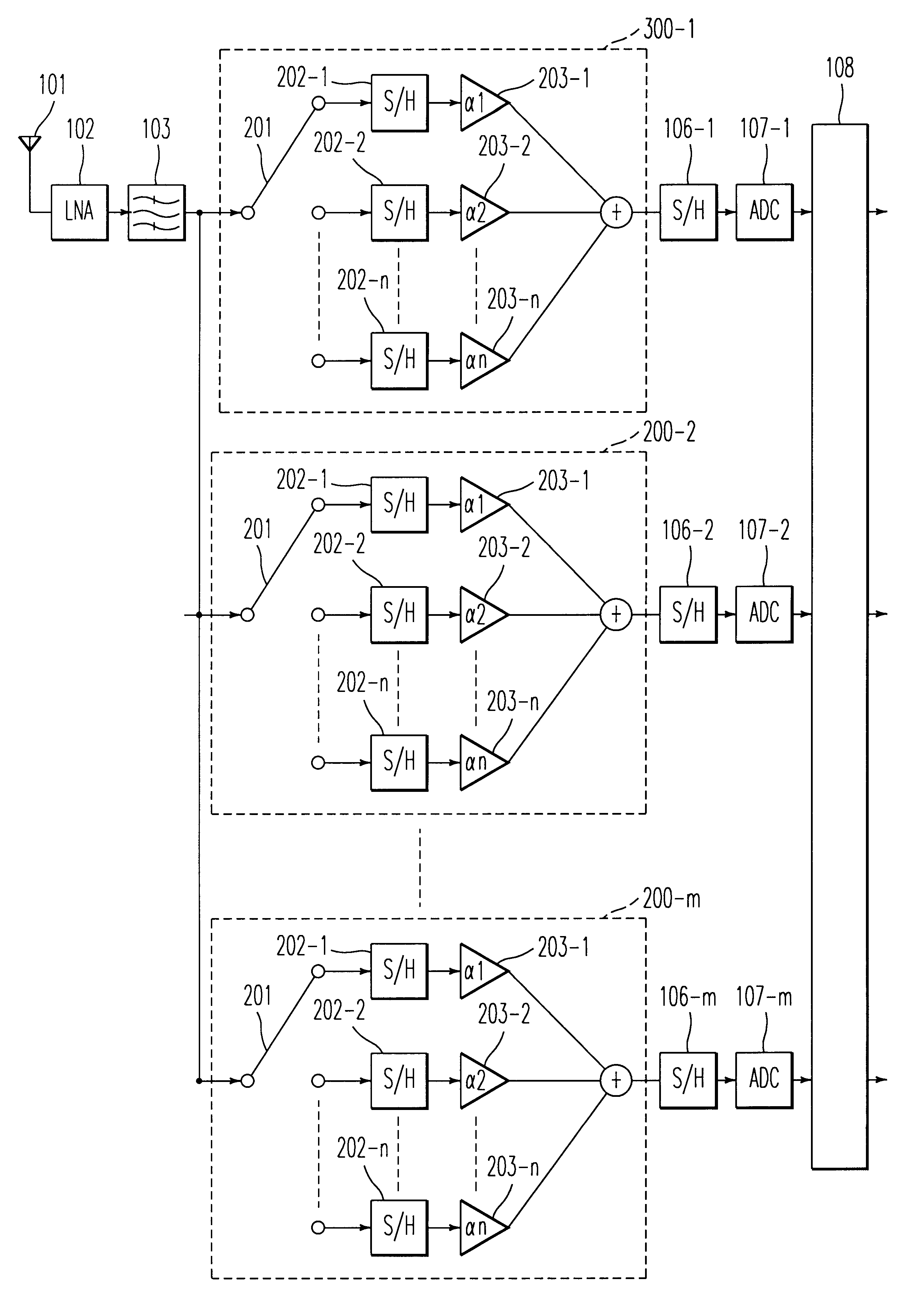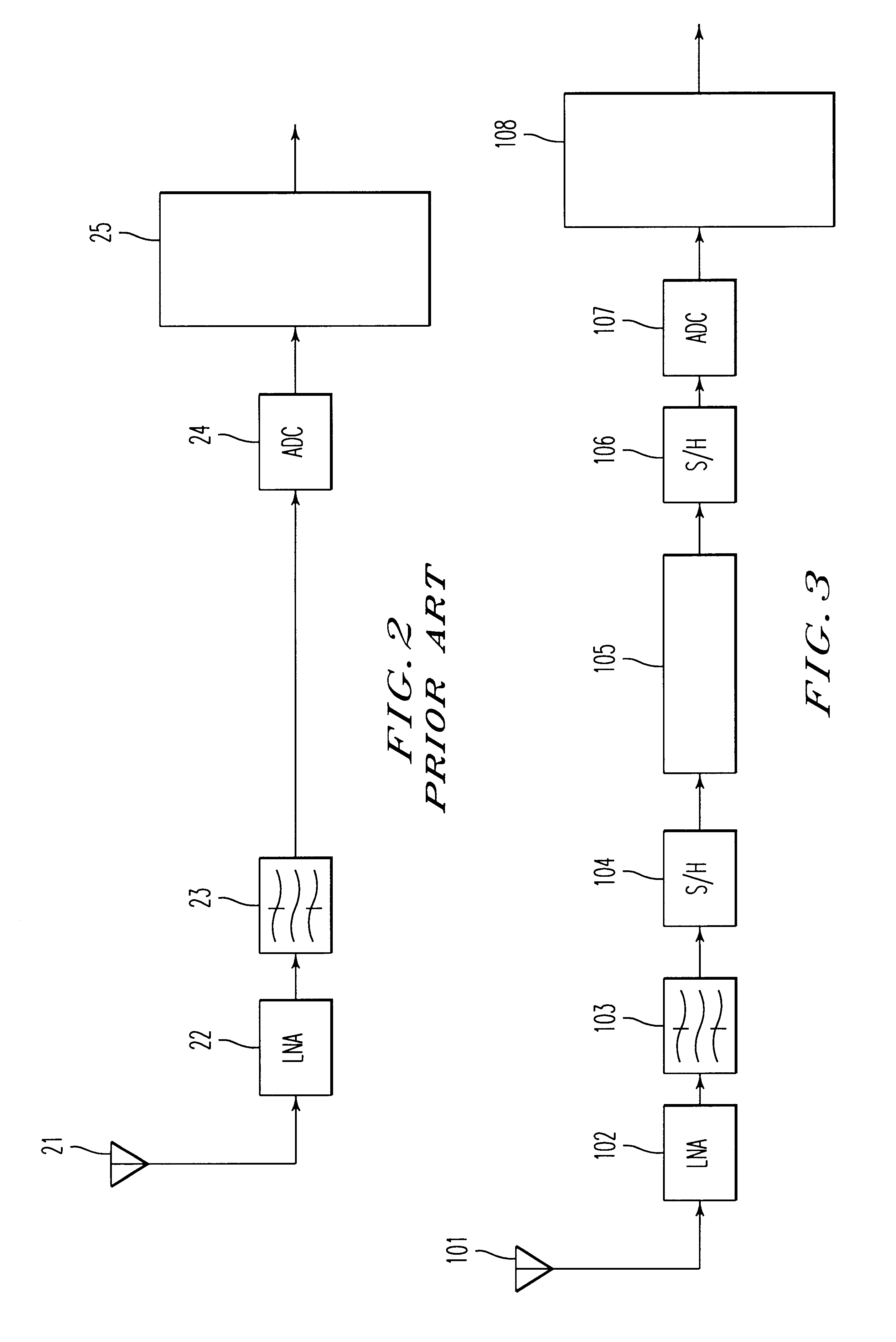Sampling system
a sampling system and sampling technology, applied in the field of sampling systems, can solve the problems of large power consumption, difficult circuit size reduction, and complicated circuits
- Summary
- Abstract
- Description
- Claims
- Application Information
AI Technical Summary
Problems solved by technology
Method used
Image
Examples
first embodiment
[First Embodiment]
FIG. 3 is a block diagram showing the structure of a radio receiving device using a sampling system of a first embodiment of the present invention. A modulated signal received by an antenna 101 is amplified by a low noise amplifier (LNA) 102 and is then input to a band-pass filter 103 having a relatively moderate characteristic for suppressing an image signal.
The signal output from the band-pass filter 103 is over-sampled by a first sample and hold circuit 104. That is, the sampling frequency fs1 of the first sample and hold circuit 104 is set at a frequency higher than the signal band fb of the modulated signal, or more concretely, at a frequency higher than the signal band fb by twice or more. The first sample and hold circuit 104 oversamples with respect to the input signal band.
When the sampling frequency of the first sample and hold circuit 104 is set with respect to the carrier frequency fin of the modulated signal at fs1=fin / N, the modulated signal is freque...
second embodiment
[Second Embodiment]
FIG. 4 is a block diagram showing the structure of a radio receiving device using a sampling system of a second embodiment of the present invention. The present embodiment is arranged such that the part of the first sample and hold circuit 104 and the analog decimation filter 105 in FIG. 3 is replaced by a first sample and hold circuit 200 having a filtering function.
A modulated signal received by the antenna 101 is amplified by the low noise amplifier (LNA) 102 and is then input to the band-pass filter 103 having a relatively moderate characteristic for suppressing an image signal.
The signal output from the band-pass filter 103 is input to the sample and hold circuit 200 having the first filtering function to be sampled with the sampling frequency fs1 which is higher than the signal band of the modulated signal, similarly to the first embodiment. In the sample and hold circuit 200 having the first filtering function, the input signal is input sequentially to a pl...
third embodiment
[Third Embodiment]
FIG. 5 is a block diagram showing the structure of a radio receiving device using a sampling system of a third embodiment of the present invention. The present embodiment is arranged such that the part of the first sample and hold circuit 104, the analog decimation filter 105 and the second sample and hold circuit 106 in FIG. 3 are replaced by a sample and hold circuit 300 having the first and second sample and hold circuit which functions also as a filter in FIG. 5. FIG. 6 is a timing chart for explaining the operation of the radio receiving device shown in FIG. 5.
In FIG. 5, a modulated signal received by the antenna 101 is amplified by the low noise amplifier (LNA) 102 and is then input to the band-pass filter 103 having a relatively moderate characteristic for suppressing an image signal. The signal output from the band-pass filter 103 is input to the first and second sample and hold circuit 300 which functions also as a filter. The sample and hold circuit 300 h...
PUM
 Login to View More
Login to View More Abstract
Description
Claims
Application Information
 Login to View More
Login to View More - R&D
- Intellectual Property
- Life Sciences
- Materials
- Tech Scout
- Unparalleled Data Quality
- Higher Quality Content
- 60% Fewer Hallucinations
Browse by: Latest US Patents, China's latest patents, Technical Efficacy Thesaurus, Application Domain, Technology Topic, Popular Technical Reports.
© 2025 PatSnap. All rights reserved.Legal|Privacy policy|Modern Slavery Act Transparency Statement|Sitemap|About US| Contact US: help@patsnap.com



